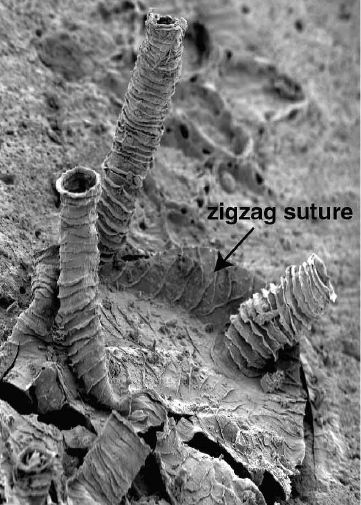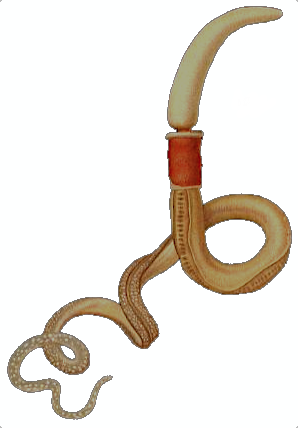|
Pterobranchia
Pterobranchia, members of which are often called pterobranchs, is a class of small worm-shaped animals. They belong to the Hemichordata, and live in secreted tubes on the ocean floor. Pterobranchia feed by filtering plankton out of the water with the help of cilia attached to tentacles. There are about 25 known living pterobranch species in three genera, which are '' Rhabdopleura'', '' Cephalodiscus'', and '' Atubaria''. On the other hand, there are several hundred extinct genera, some of which date from the Cambrian Period. The class Pterobranchia was established by Ray Lankester in 1877. It contained, at that time, the single genus '' Rhabdopleura''. ''Rhabdopleura'' was at first regarded as an aberrant polyzoon, but when the ''Challenger'' report on '' Cephalodiscus'' was published in 1887, it became clear that ''Cephalodiscus'', the second genus now included in the order, had affinities with the Enteropneusta. Electron microscope studies have suggested that pterobranch ... [...More Info...] [...Related Items...] OR: [Wikipedia] [Google] [Baidu] |
Hemichordata
Hemichordata ( ) is a phylum which consists of triploblastic, eucoelomate, and bilaterally symmetrical marine deuterostome animals, generally considered the sister group of the echinoderms. They appear in the Lower or Middle Cambrian and include two main classes: Enteropneusta (acorn worms), and Pterobranchia. A third class, Planctosphaeroidea, is known only from the larva of a single species, '' Planctosphaera pelagica''. The class Graptolithina, formerly considered extinct, is now placed within the pterobranchs, represented by a single living genus '' Rhabdopleura''. Acorn worms are solitary worm-shaped organisms. They generally live in burrows (the earliest secreted tubes) and are deposit feeders, but some species are pharyngeal filter feeders, while the family are free living detritivores. Many are well known for their production and accumulation of various halogenated phenols and pyrroles. Pterobranchs are filter-feeders, mostly colonial, living in a collagenous ... [...More Info...] [...Related Items...] OR: [Wikipedia] [Google] [Baidu] |
Cephalodiscida
Cephalodiscida is one of two orders in the class Pterobranchia, which are small, worm-shaped animals. Members belong to the hemichordata, hemichordates. Species in this order are Sessility (zoology), sessile, living in clear water and secretion, secrete tubes on the ocean floor. Taxonomy The order is a small one, with only two known families, each containing a single extant genus. The validity of the family Atubaridae, who has only a sole member, is regarded as questionable. * Order Cephalodiscida Fowler 1892 ** Family Cephalodiscidae Harmer 1905 *** Genus †''Aellograptus'' Obut 1964 *** Genus †''Eocephalodiscus'' Kozlowski 1938 ex Kozlowski 1949 *** Genus †''Melanostrophus'' Öpik 1930 ex Öpik 1933 *** Genus †''Pterobranchites'' Kozlowski 1967 *** Genus ''Atubaria'' Sato 1936 *** Genus ''Cephalodiscus'' M'Intosh 1882 ** Family †Rotaciurcidae Briggs and Koch 2023 *** Genus †''Rotaciurca'' Briggs and Koch 2023 References Harmer. S. F. 1905. The Pterobranchia ol ... [...More Info...] [...Related Items...] OR: [Wikipedia] [Google] [Baidu] |
Rhabdopleura
''Rhabdopleura'' is a genus of colonial sessile hemichordates belonging to the Pterobranchia class. They are exclusively marine, benthic organisms whose species occur within all major oceans and range in habitat from intertidal to c. 900 m.Gordon, D.P., Quek, Z.B.R., Orr, R.J.S. et al. (2023). Morphological diversity and a ribosomal phylogeny of Rhabdopleura (Hemichordata: Graptolithina) from the Western Pacific (Singapore and New Zealand), with implications for a re-evaluation of rhabdopleurid species diversity. Mar. Biodivers. 53, 4 (2023). https://doi.org/10.1007/s12526-022-01310-3 As one of the oldest living genera with a fossil record dating back to the Middle Cambrian, it is also considered to be the only living genus of graptolites. ''Rhabdopleura'' is the best studied pterobranch in developmental biology. Research in the 2010s by Jörg Maletz and other paleontologists and biologists have demonstrated that ''Rhabdopleura'' is an extant graptolite. History The first ev ... [...More Info...] [...Related Items...] OR: [Wikipedia] [Google] [Baidu] |
Graptolite
Graptolites are a group of colonial animals, members of the subclass Graptolithina within the class Pterobranchia. These filter-feeding organisms are known chiefly from fossils found from the Middle Cambrian ( Miaolingian, Wuliuan) through the Lower Carboniferous ( Mississippian). A possible early graptolite, ''Chaunograptus'', is known from the Middle Cambrian. Recent analyses have favored the idea that the living pterobranch '' Rhabdopleura'' represents an extant graptolite which diverged from the rest of the group in the Cambrian. Fossil graptolites and ''Rhabdopleura'' share a colony structure of interconnected zooids housed in organic tubes (theca) which have a basic structure of stacked half-rings (fuselli). Most extinct graptolites belong to two major orders: the bush-like sessile Dendroidea and the planktonic, free-floating Graptoloidea. These orders most likely evolved from encrusting pterobranchs similar to ''Rhabdopleura''. Due to their widespread abundance, pl ... [...More Info...] [...Related Items...] OR: [Wikipedia] [Google] [Baidu] |
Cephalodiscus
''Cephalodiscus'' is a genus of hemichordates in the monotypic family Cephalodiscidae of the order Cephalodiscida. Description All known species live in a secreted coenecium attached to a rock substrate. Unlike ''Rhabdopleura'', ''Cephalodiscus'' species do not form large colonies and are only pseudocolonial, but they do share a common area with individual buds for each zooid. ''Cephalodiscus'' zooids are also more mobile than their ''Rhabdopleura'' counterparts, and are able to move around within tubaria. ''Cephalodiscus'' zooids can be produced via asexual budding. There are a few pairs of tentacled arms, whereas ''Rhabdopleura'' has only one pair of arms. Species 19 living species of ''Cephalodiscus'' have been described: * '' Cephalodiscus agglutinans'' Harmer & Ridewood, 1914 * '' Cephalodiscus atlanticus'' Bayer, 1962 * '' Cephalodiscus australiensis'' Johnston & Muirhead, 1951 * '' Cephalodiscus calciformis'' Emig, 1977 * '' Cephalodiscus densus'' Andersson 1907 ' ... [...More Info...] [...Related Items...] OR: [Wikipedia] [Google] [Baidu] |
Acorn Worm
The acorn worms or Enteropneusta are a hemichordate class of invertebrates consisting of one order of the same name. The closest non-hemichordate relatives of the Enteropneusta are the echinoderms. There are 111 known species of acorn worm in the world, the main species for research being '' Saccoglossus kowalevskii''. Two families— Harrimaniidae and Ptychoderidae—separated at least 370 million years ago. Until recently, it was thought that all species lived in the sediment on the seabed, subsisting as deposit feeders or suspension feeders. However, the early 21st century has seen the description of a new family, the Torquaratoridae, evidently limited to the deep sea, in which most of the species crawl on the surface of the ocean bottom and alternatively rise into the water column, evidently to drift to new foraging sites. It is assumed that the ancestors of acorn worms used to live in tubes like their relatives Pterobranchia, but that they eventually started to live a s ... [...More Info...] [...Related Items...] OR: [Wikipedia] [Google] [Baidu] |
Cephalodiscus Nigrescens
''Cephalodiscus nigrescens'' is a sessile hemichordate belonging to the order Cephalodiscida. Parasites The parasitic protozoa Protozoa (: protozoan or protozoon; alternative plural: protozoans) are a polyphyletic group of single-celled eukaryotes, either free-living or parasitic, that feed on organic matter such as other microorganisms or organic debris. Historically ...n '' Neurosporidium cephalodisci'' has been found in the nervous system of ''Cephalodiscus nigrescens''.Maletz, Jörg. (2017) ''Graptolite Paleobiology''. Wiley-Blackwell. References nigrescens Animals described in 1905 {{hemichordate-stub ... [...More Info...] [...Related Items...] OR: [Wikipedia] [Google] [Baidu] |
Zooid
A zooid or zoöid is an animal that is part of a colonial animal. This lifestyle has been adopted by animals from separate unrelated taxa. Zooids are multicellular; their structure is similar to that of other solitary animals. The zooids can either be directly connected by tissue (e.g. corals, Catenulida, Siphonophorae, Pyrosome or Ectoprocta) or share a common exoskeleton (e.g. Bryozoa or Pterobranchia). The colonial organism as a whole is called a ''zoon'' , plural ''zoa'' (from Ancient Greek meaning animal; plural , ). Zooids can exhibit polymorphism. For instance, extant bryozoans may have zooids adapted for different functions, such as feeding, anchoring the colony to the substratum and for brooding embryos. However, fossil bryozoans are only known by the colony structures that the zooids formed during life. There are correlations between the size of some zooids and temperature. Variations in zooid size within colonies of fossils can be used as an indicator of th ... [...More Info...] [...Related Items...] OR: [Wikipedia] [Google] [Baidu] |
Atubaria
''Atubaria heterolopha'' is a species of hemichordates in the monotypic genus ''Atubaria'' and in the monotypic family Atubaridae. This taxon belongs to the pterobranchian order Cephalodiscida. It was described by Tadao Sato in 1936 from specimens found feeding on a colony of the hydrozoan '' Dycoryne conferta'' in Sagami Bay, Japan. Description The characteristics of this pterobranch species include a 1–5 mm long zooid, a collar with four pairs of tentaculated arms, a single pair of pharyngeal slits, and a solitary and sedentary behaviour. It closely resembles ''Cephalodiscus ''Cephalodiscus'' is a genus of hemichordates in the monotypic family Cephalodiscidae of the order Cephalodiscida. Description All known species live in a secreted coenecium attached to a rock substrate. Unlike ''Rhabdopleura'', ''Cephalodiscu ...'' members. References {{taxonbar, from=Q3827927 Pterobranchia Animals described in 1936 ... [...More Info...] [...Related Items...] OR: [Wikipedia] [Google] [Baidu] |
Ocean Floor
The seabed (also known as the seafloor, sea floor, ocean floor, and ocean bottom) is the bottom of the ocean. All floors of the ocean are known as seabeds. The structure of the seabed of the global ocean is governed by plate tectonics. Most of the ocean is very deep, where the seabed is known as the abyssal plain. Seafloor spreading creates mid-ocean ridges along the center line of major ocean basins, where the seabed is slightly shallower than the surrounding abyssal plain. From the abyssal plain, the seabed slopes upward toward the continents and becomes, in order from deep to shallow, the continental rise, slope, and shelf. The depth within the seabed itself, such as the depth down through a sediment core, is known as the "depth below seafloor". The ecological environment of the seabed and the deepest waters are collectively known, as a habitat for creatures, as the " benthos". Most of the seabed throughout the world's oceans is covered in layers of marine sediments. Cate ... [...More Info...] [...Related Items...] OR: [Wikipedia] [Google] [Baidu] |
Order (biology)
Order () is one of the eight major hierarchical taxonomic ranks in Linnaean taxonomy. It is classified between family and class. In biological classification, the order is a taxonomic rank used in the classification of organisms and recognized by the nomenclature codes. An immediately higher rank, superorder, is sometimes added directly above order, with suborder directly beneath order. An order can also be defined as a group of related families. What does and does not belong to each order is determined by a taxonomist, as is whether a particular order should be recognized at all. Often there is no exact agreement, with different taxonomists each taking a different position. There are no hard rules that a taxonomist needs to follow in describing or recognizing an order. Some taxa are accepted almost universally, while others are recognized only rarely. The name of an order is usually written with a capital letter. For some groups of organisms, their orders may follow consist ... [...More Info...] [...Related Items...] OR: [Wikipedia] [Google] [Baidu] |
Ray Lankester
Sir Edwin Ray Lankester (15 May 1847 – 13 August 1929) was a British zoologist.New International Encyclopaedia. An invertebrate zoologist and evolutionary biologist, he held chairs at University College London and Oxford University. He was the third Director of the Natural History Museum, London, and was awarded the Copley Medal of the Royal Society. Life Ray Lankester was born on 15 May 1847 on Burlington Street in London, the son of Edwin Lankester, a coroner and doctor-naturalist who helped eradicate cholera in London, and his wife, the botanist and author Phebe Lankester. Ray Lankester was probably named after the naturalist John Ray: his father had just edited the memorials of John Ray for the Ray Society. In 1855 Ray went to boarding school at Leatherhead, and in 1858 to St Paul's School. His university education was at Downing College, Cambridge, and Christ Church, Oxford; he transferred from Downing, after five terms, at his parents' behest because Christ Church ... [...More Info...] [...Related Items...] OR: [Wikipedia] [Google] [Baidu] |





